Elderly patients suffering from chronic cardio-pulmonary diseases commonly experience acute respiratory failure. As in younger patients, a well-known therapeutic approach of noninvasive mechanical ventilation is able to prevent orotracheal intubation in a large number of severe scenarios in elderly patients. In addition, this type of ventilation is frequently applied in elderly patients who refuse intubation for invasive mechanical ventilation. The rate of failure of noninvasive ventilation may be reduced by means of the integration of new technological devices (i.e., high-flow nasal cannula, extracorporeal CO2 removal, cough assistance and high-frequency chest wall oscillation, and fiberoptic bronchoscopy). Ethical issues with end-of-life decisions and the choice of the environment are not clearly defined in the treatment of elderly with acute respiratory insufficiency.
Cite this article as: Scala R, Ciarleglio G, Maccari U, et al. Ventilator Support and Oxygen Therapy in Palliative and End-of-Life Care in the Elderly. Turk Thorac J 2020; 21(1): 54-60.



.png)

